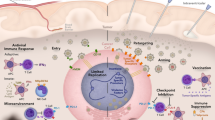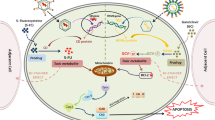Abstract
Herpes simplex virus thymidine kinase (HSV-TK) and Escherichia coli cytosine deaminase (CD) are non-mammalian enzymes capable of converting innocuous prodrugs into cytotoxic metabolites. Both enzymes have been utilized independently, as well as together in ‘suicide’ gene therapy protocols to eliminate tumor cells in vitro and in vivo. We have used a set of replication defective HSV vectors expressing either or both enzymes to compare the efficacies of single and double suicide gene therapies in the 9L gliosarcoma model in vitro and in vivo. In cell culture experiments at high and low multiplicities of infection, combined expression of the two genes by vector TOCD/TK along with exposure to the matching prodrugs (ganciclovir and 5-fluorocytosine) showed increased cytotoxicity compared with exposure to either prodrug alone. However, the two gene combination was inferior to single gene treatments, suggesting that HSVtk and CD are mutually counteractive in the prodrug-dependent killing of glioma cells. In animal experiments, survival was not significantly prolonged by administration of both prodrugs to TOCD/TK-treated animals, while each single gene/prodrug pair resulted in increased survival. These results indicate that single suicide gene systems employing HSVtk or CD may be preferable over combinations of the two.
This is a preview of subscription content, access via your institution
Access options
Subscribe to this journal
Receive 12 print issues and online access
$259.00 per year
only $21.58 per issue
Buy this article
- Purchase on Springer Link
- Instant access to full article PDF
Prices may be subject to local taxes which are calculated during checkout




Similar content being viewed by others
References
Arcicasa M et al. Results of three consecutive combined treatments for malignant gliomas. Ten-year experience at a single institution Am J Clin Oncol 1994 17: 4437–443
Mahaley M Jr . National survey of patterns of care for brain-tumor patients J Neurosurg 1989 71: 826–836
Ushio Y . Treatment of gliomas in adults Curr Opin Oncol 1991 3: 467–475
Walker P, Dietrich P . Immune escape of gliomas Prog Brain Res 2001 132: 685–698
Mullen C, Kilstrup M, Blaese R . Transfer of the bacterial gene for cytosine deaminase to mammalian cells confers lethal sensitivity to 5-fluorocytosine: a new negative selection system Proc Natl Acad Sci, USA 1992 89: 33–37
Freeman S et al. The ‘bystander effect’: tumor regression when a fraction of the tumor mass is genetically modified Cancer Res 1993 53: 5274–5283
Aghi M et al. Synergistic anticancer effects of ganciclovir/thymidine kinase and 5-fluorocytosine/cytosine deaminase gene therapies J Natl Cancer Inst 1998 90: 370–380
Blackburn R, Galoforo S, Corry P, Lee Y . Adenoviral-mediated transfer of a heat-inducible double suicide gene into prostate carcinoma cells Cancer Res 1998 58: 1358–1362
Freytag S et al. A novel three-pronged approach to kill cancer cells selectively: concomitant viral, double suicide gene, and radiotherapy Hum Gene Ther 1998 9: 1323–1333
Ichikawa T et al. In vivo efficacy and toxicity of 5-fluorocytosine/cytosine deaminase gene therapy for malignant gliomas mediated by adenovirus Cancer Gene Ther 2000 7: 74–82
Rogulski K, Kim J, Kim S, Freytag S . Glioma cells transduced with an Esherichia coli CD/HSV-1 TK fusion gene exhibit enhanced metabolic suicide and radiosensitivity Hum Gene Ther 1997 8: 73–85
Rogulski K et al. Pronounced antitumor effects and tumor radiosensitization of double suicide gene therapy Clin Cancer Res 1997 11: 2081–2088
Uckert W et al. Double suicide gene (cytosine deaminase and herpes simplex virus thymidine kinase) but not single gene transfer allows reliable elimination of tumor cells in vivo Hum Gene Ther 1998 9: 855–865
Krisky D et al. Rapid method for construction of recombinant HSV gene transfer vectors Gene Therapy 1997 4: 1120–1125
Marconi P et al. Replication-defective HSV vectors for gene transfer in vivo Proc Natl Acad Sci USA 1996 93: 11319–11320
Krisky D et al. Deletion of multiple immediate early genes from herpes simplex virus reduces cytotoxicity and permits long-term gene expression in neurons Gene Therapy 1998 5: 1593–1603
Mosmann T . Rapid colorimetric assay for cellular growth and survival: application to proliferation and cytotoxicity assays J Immunol Meth 1983 65: 55–63
Krisky D et al. Development of herpes simplex virus replication-defective multigene vectors for combination gene therapy applications Gene Therapy 1998 5: 1517–1530
Moriuchi S et al. Enhanced tumor-cell killing in the presence of ganciclovir by HSV-1 vector-directed co-expression of human TNF-α and HSV thymidine kinase Cancer Res 1998 58: 5731–5737
Moriuchi S et al. HSV vector cytotoxicity is inversely correlated with effective TK/GCV suicide gene therapy of rat gliosarcoma Gene Therapy 2000 7: 1483–1490
Niranjan A et al. Effective treatment of experimental glioblastoma by HSV vector-mediated TNF-a and HSV-tk gene transfer in combination with radiosurgery and ganciclovir administration Mol Ther 2000 2: 114–120
Summers W, Wagner M, Summers W . Possible peptide chain termination mutants in thymidine kinase gene of a mammalian virus, herpes simplex virus Proc Natl Acad Sci USA 1975 72: 4081–4084
Acknowledgements
We wish to thank Kate Sullivan and Songhui Li of the Department of Molecular Genetics and Biochemistry for technical assistance. This work was supported by NIH Grants GM 34534 and AR44526 to JCG.
Author information
Authors and Affiliations
Rights and permissions
About this article
Cite this article
Moriuchi, S., Wolfe, D., Tamura, M. et al. Double suicide gene therapy using a replication defective herpes simplex virus vector reveals reciprocal interference in a malignant glioma model. Gene Ther 9, 584–591 (2002). https://doi.org/10.1038/sj.gt.3301693
Received:
Accepted:
Published:
Issue Date:
DOI: https://doi.org/10.1038/sj.gt.3301693
Keywords
This article is cited by
-
Combined enzyme/prodrug treatment by genetically engineered AT-MSC exerts synergy and inhibits growth of MDA-MB-231 induced lung metastases
Journal of Experimental & Clinical Cancer Research (2015)
-
A Novel Double-Enhanced Suicide Gene Therapy in a Colon Cancer Cell Line Mediated by Gef and Apoptin
BioDrugs (2014)
-
Double suicide genes selectively kill human umbilical vein endothelial cells
Virology Journal (2011)
-
Rat brain tumor models in experimental neuro-oncology: the C6, 9L, T9, RG2, F98, BT4C, RT-2 and CNS-1 gliomas
Journal of Neuro-Oncology (2009)



